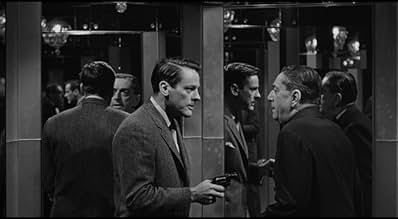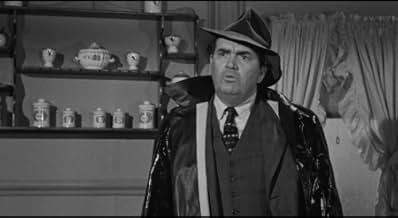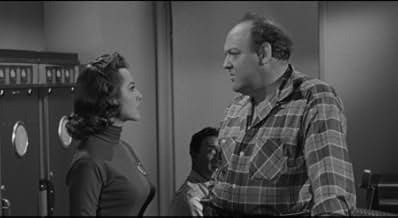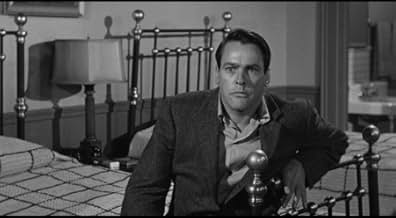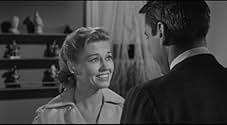IMDb रेटिंग
6.4/10
1.4 हज़ार
आपकी रेटिंग
अपनी भाषा में प्लॉट जोड़ेंA New Orleans musician has a nightmare about killing a man in a strange house but he suspects that it really happened.A New Orleans musician has a nightmare about killing a man in a strange house but he suspects that it really happened.A New Orleans musician has a nightmare about killing a man in a strange house but he suspects that it really happened.
- निर्देशक
- लेखक
- स्टार
Ralph Brooks
- Oscar - the Bartender
- (बिना क्रेडिट के)
Jack Chefe
- Nightclub Waiter
- (बिना क्रेडिट के)
John Mitchum
- Onlooker at Stan's Suicide Attempt
- (बिना क्रेडिट के)
Cosmo Sardo
- Nightclub Patron
- (बिना क्रेडिट के)
फ़ीचर्ड समीक्षाएं
Maxwell Shea remade his own film; the cheap Noir thriller "Fear in the Night" as 1956's "Nightmare" with a bigger budget and an A-list cast, yet the film follows the formers structure so closely you wonder what was the point. The two films are basically the same movie yet where they differ "Fear in the Night" comes out the superior, its hokey plot felt more at home with its low-budget and it was nicely complimented by an effective dark atmosphere, also the films conclusion and hallucination/dream scenes were sharper and more creatively shot . The one thing "Nightmare" has over the original is in the cast, 'Noir' staple and the always great Edward G Robinson, takes the role of the protagonist cop brother in-law (which was fairly flat in the original) and injects it with the warmth and vitality that is expected from him. Kevin Mcarthy has played the 'average man pushed to hysteria' role before but for good reason; he does it well, his performance is preferable to Deforrest Kelly's big eye-balled take on the same character. Even though its neck and neck with the original "Nightmare" comes out short, which doesn't make it a bad film, I just wouldn't recommend it if you've seen the original, but if you haven't there are some cheap B-movie thrills to be fond in the A-list surroundings.
******SPOILERS****** Unbelievably heavy handed movie that telegraphs it's story to the audience so directly that you think it's a commercial for Western Union. Musician Stan Grayson, Kevin McCarthy, walks around most of the time in a zombie-like induced state and when he's conscious with his eyes bulging out of his head and looking like he's going into cardiac arrest at any moment that you want to run to the nearest phone and call 911 for help.
Waking up one morning at his room at the Hotel New Orleans from a nightmare that he had about him being a hall of mirrors and getting into a fight where he kills someone in self-defense Stan then opens a door and falls into a dark and bottomless pit. Stan looks in the mirror and sees marks on his throat and blood on his arm as well as having both a key and a button from the man's suit that was in his dream.
The movie tries to be both hip and cool when it comes to Stan's mental state and how it was manipulated by the killer Dr. Belknap/Harry Britten, Gage Clarke, in a pseudo/psychological manner that was very common in films about mental issues back in the 1940's and 50's but seeing it now it comes across as both silly and amateurish.
The movie also tries to make a big deal about the killer being a doctor who is an expert in psychological studies just by judging from the books that he has in his private library, but at the same time make him physically violent. He runs over his wife with a car and shoots it out with the police in order to kill him off at the end of the movie.
Edward G.Robinson, Det. Rene Bressard, is very good in the movie as Stan's brother in-law and New Orleans police detective. Rene at first suspects Stan of the murders but then, like a good detective should, when he sees where the evidence leads him realizes that there is more to the murders then what he at first thought.
Kevin McCarthy seems to overact in the movie, or better yet was over-directed, by passing out about a half dozen times and coming across as being brain-dead even when he wasn't under hypnosis. The movie tells the audience that you can't do anything under hypnosis that you won't do when your conscious like murder at the same time we see Stan being told to drown himself in the swamp by Dr. Belknap and then willingly do it.
Granted Stan tried to kill himself earlier in the film by jumping from the fifteen floor of the Hotel New Orleans but that was when he thought that he was a murderer. By the time he was told to drown himself he already knew that he didn't commit any murders so there was no conscious or subconscious reasons for him to do it. Stan was eventually saved from drowning by his brother in-law Rene.
Virginia Christine, Sue Bressard, was very good as Stan's sister and Rene's pregnant wife who developed a hearty appetite because of the condition that she was in and Gage Clarke, Dr. Belknap/ Harry Britten, was effective as the highly educated murderer. Connie Russell, Gina, as Stan's love interest had really nothing to do in the movie but stand around and look pretty, she did sing two songs.
The movie "Nightmare" can be forgiven for it's heavy handedness since it was the norm in movies about psychiatric issues back in those days, 1955, but at the same time can't be taken seriously by anyone watching it now in 2004.
Waking up one morning at his room at the Hotel New Orleans from a nightmare that he had about him being a hall of mirrors and getting into a fight where he kills someone in self-defense Stan then opens a door and falls into a dark and bottomless pit. Stan looks in the mirror and sees marks on his throat and blood on his arm as well as having both a key and a button from the man's suit that was in his dream.
The movie tries to be both hip and cool when it comes to Stan's mental state and how it was manipulated by the killer Dr. Belknap/Harry Britten, Gage Clarke, in a pseudo/psychological manner that was very common in films about mental issues back in the 1940's and 50's but seeing it now it comes across as both silly and amateurish.
The movie also tries to make a big deal about the killer being a doctor who is an expert in psychological studies just by judging from the books that he has in his private library, but at the same time make him physically violent. He runs over his wife with a car and shoots it out with the police in order to kill him off at the end of the movie.
Edward G.Robinson, Det. Rene Bressard, is very good in the movie as Stan's brother in-law and New Orleans police detective. Rene at first suspects Stan of the murders but then, like a good detective should, when he sees where the evidence leads him realizes that there is more to the murders then what he at first thought.
Kevin McCarthy seems to overact in the movie, or better yet was over-directed, by passing out about a half dozen times and coming across as being brain-dead even when he wasn't under hypnosis. The movie tells the audience that you can't do anything under hypnosis that you won't do when your conscious like murder at the same time we see Stan being told to drown himself in the swamp by Dr. Belknap and then willingly do it.
Granted Stan tried to kill himself earlier in the film by jumping from the fifteen floor of the Hotel New Orleans but that was when he thought that he was a murderer. By the time he was told to drown himself he already knew that he didn't commit any murders so there was no conscious or subconscious reasons for him to do it. Stan was eventually saved from drowning by his brother in-law Rene.
Virginia Christine, Sue Bressard, was very good as Stan's sister and Rene's pregnant wife who developed a hearty appetite because of the condition that she was in and Gage Clarke, Dr. Belknap/ Harry Britten, was effective as the highly educated murderer. Connie Russell, Gina, as Stan's love interest had really nothing to do in the movie but stand around and look pretty, she did sing two songs.
The movie "Nightmare" can be forgiven for it's heavy handedness since it was the norm in movies about psychiatric issues back in those days, 1955, but at the same time can't be taken seriously by anyone watching it now in 2004.
If you can get past the improbable key to the mystery, the rest of the movie has some good, strong points. The first twenty minutes plunge us into McCarthy's nightmarish events that may or may not have actually happened. We don't know for sure and neither does he, but there are the scratches on his arm. Did he kill those people or not. The surreal effects are impressively done.
McCarthy delivers a gripping performance, as good as Invasion of the Body Snatchers (also 1956), and much better than expected for a B-movie. In short, he makes us believe that his dilemma, however improbable, is real and not just a story construct. Without that intensity drawing us in, the movie would, I think, amount to little more than a mildly interesting walk-through.
The New Orleans locations provide a clever anchor to the real world, and a good setting for the colorful jazz scenes. However, a 63-year old Robinson is at least 10 years too old for the brother-in-law part even though he manages the cop role well. And can we really believe the chance occurrence onto the scene-of-the-crime mansion in all that unfamiliar backcountry. Unfortunately, the script requires more than just an ordinary suspension of disbelief. Too bad the script couldn't work in more bayou scenes. Those coming at the end are really creepy and nightmarish in their own right. Too bad also that the excellent McCarthy made so few films, preferring, I gather, stage productions instead. All in all, an interesting if regrettably flawed little movie.
McCarthy delivers a gripping performance, as good as Invasion of the Body Snatchers (also 1956), and much better than expected for a B-movie. In short, he makes us believe that his dilemma, however improbable, is real and not just a story construct. Without that intensity drawing us in, the movie would, I think, amount to little more than a mildly interesting walk-through.
The New Orleans locations provide a clever anchor to the real world, and a good setting for the colorful jazz scenes. However, a 63-year old Robinson is at least 10 years too old for the brother-in-law part even though he manages the cop role well. And can we really believe the chance occurrence onto the scene-of-the-crime mansion in all that unfamiliar backcountry. Unfortunately, the script requires more than just an ordinary suspension of disbelief. Too bad the script couldn't work in more bayou scenes. Those coming at the end are really creepy and nightmarish in their own right. Too bad also that the excellent McCarthy made so few films, preferring, I gather, stage productions instead. All in all, an interesting if regrettably flawed little movie.
In the late 1940s, director Maxwell Shane made a very low budget psychological thriller called Fear in the Dark -- about a man waking from a nightmare that he's murdered a stranger, only to find it to be true. In 1956, Shane decided to remake it as Nightmare, with a name cast (Kevin McCarthy -- Mary's brother, for the record -- as the luckless dreamer, Edward G. Robinson as his brother-in-law the homicide cop). It's a very close remake, not as pointlessly literal as Gus Van Sant's cloning of Psycho, but with little changed except a better and more integrated jazz score. In sum, Nightmare boasts better acting and better production values, all of which serve to point up the basic cheesiness of the plot. The earlier version, looking a lot like a nightmare itself, lends its own low-rent integrity to Cornell Woolrich's bizarre vision.
This One has an Interesting Pedigree.
It is a Remake of a Film-Noir, Fear in the Night (1946) from the same Director, the Prolific (mostly screenplays) Maxwell Shane. Everybody Endlessly compares the two Movies,
This is a Distinctive Noir, at the End of the Cycle and it is Remarkable because it includes almost every Film-Noir Trope starting with the Title. Obsessive Fans of the Genre could make a List.
The least Impressive thing about "Nightmare" is the Print. TCM, a stickler for finding the Best Available, showed a very Unimpressive Version that was Weak all around. The Contrast is "Grayish" and the Look is very Flat. That Visual Disappointment Aside, the Film reminds of the Great Style that was all but Forgotten by 1956.
Seemingly Filmed on a Very Low Budget, it still manages to Conjure Up the Atmosphere of True Film-Noir. The On-Location Footage on the Streets and Bayou are "Nightmarish". The Film feels Odd and Off-Beat adding to the Enjoyment.
The Cast lead by Edward G. Robinson and Kevin Mccarthy give the Movie Gravitas and the Story, by Cornell Woolrich, is Rich with Mysterious Happenings and Dreamlike Displays.
If every Reviewer on Earth hasn't Spoiled the Ending You will Undoubtedly have a Fun Time with this Mystery Movie.
Highly Recommended for Low-Budget Entertainment.
This 1956 Film-Noir shows just what Staying Power the Genre could Generate. The Conservative Fifties, with Very Few Exceptions, had Hollywood Capitulating to Government Gawking and Back-Room Intimidation and the Cynical and Edgy Film-Noir Genre was Relegated to Cheap Second Features and within a Year or two was Abandoned Altogether.
Making a Comeback about Later, as Neo-Noir, the Movies Started Experimenting with a Renewed Energy as things were Opening Up Culturally and the Art Form found that the Freedom to Express was again winning the Public's Imagination and Imagination is obviously one of the Ingredients in the Creative Process.
It is a Remake of a Film-Noir, Fear in the Night (1946) from the same Director, the Prolific (mostly screenplays) Maxwell Shane. Everybody Endlessly compares the two Movies,
This is a Distinctive Noir, at the End of the Cycle and it is Remarkable because it includes almost every Film-Noir Trope starting with the Title. Obsessive Fans of the Genre could make a List.
The least Impressive thing about "Nightmare" is the Print. TCM, a stickler for finding the Best Available, showed a very Unimpressive Version that was Weak all around. The Contrast is "Grayish" and the Look is very Flat. That Visual Disappointment Aside, the Film reminds of the Great Style that was all but Forgotten by 1956.
Seemingly Filmed on a Very Low Budget, it still manages to Conjure Up the Atmosphere of True Film-Noir. The On-Location Footage on the Streets and Bayou are "Nightmarish". The Film feels Odd and Off-Beat adding to the Enjoyment.
The Cast lead by Edward G. Robinson and Kevin Mccarthy give the Movie Gravitas and the Story, by Cornell Woolrich, is Rich with Mysterious Happenings and Dreamlike Displays.
If every Reviewer on Earth hasn't Spoiled the Ending You will Undoubtedly have a Fun Time with this Mystery Movie.
Highly Recommended for Low-Budget Entertainment.
This 1956 Film-Noir shows just what Staying Power the Genre could Generate. The Conservative Fifties, with Very Few Exceptions, had Hollywood Capitulating to Government Gawking and Back-Room Intimidation and the Cynical and Edgy Film-Noir Genre was Relegated to Cheap Second Features and within a Year or two was Abandoned Altogether.
Making a Comeback about Later, as Neo-Noir, the Movies Started Experimenting with a Renewed Energy as things were Opening Up Culturally and the Art Form found that the Freedom to Express was again winning the Public's Imagination and Imagination is obviously one of the Ingredients in the Creative Process.
क्या आपको पता है
- ट्रिवियाWhen Stan goes out walking the morning after his nightmare, he passes by a place with a sign that says "New Orleans' Most Famous Coffee Drinking Place." That would be the Morning Call Coffee Stand that was on Decatur Street in the French Quarter. Opened in 1870, it moved to Metairie in 1974.
- गूफ़According to the elevator there are only 15 floors in the hotel, but the shot of the building from outside shows more than fifteen.
- भाव
[first lines]
Stan Grayson: At first, all I could see was this face, this beautiful babe's face, floating toward me. And in my head, was this slow, crazy melody - like a tune from another world. And then a I saw the room - a queer mirrored room. And somehow, I was inside of it. There was danger there. I knew that.
- कनेक्शनFeatured in Out of this World Super Shock Show (2007)
- साउंडट्रैकWhat's Your Sad Story
Words and Music by Richard M. Sherman (as Dick Sherman)
Performed by Connie Russell / Billy May Orchestra
टॉप पसंद
रेटिंग देने के लिए साइन-इन करें और वैयक्तिकृत सुझावों के लिए वॉचलिस्ट करें
- How long is Nightmare?Alexa द्वारा संचालित
विवरण
- चलने की अवधि1 घंटा 29 मिनट
- रंग
इस पेज में योगदान दें
किसी बदलाव का सुझाव दें या अनुपलब्ध कॉन्टेंट जोड़ें



